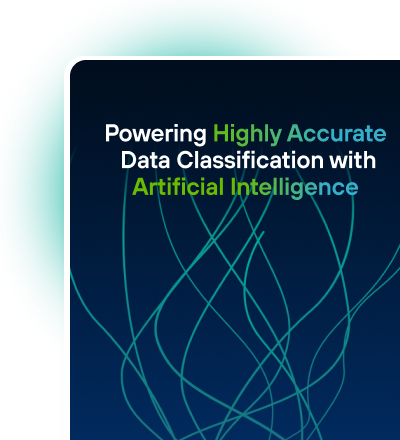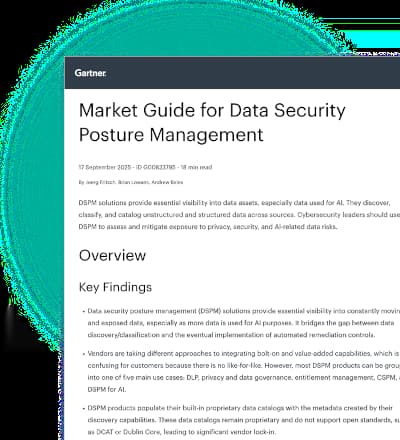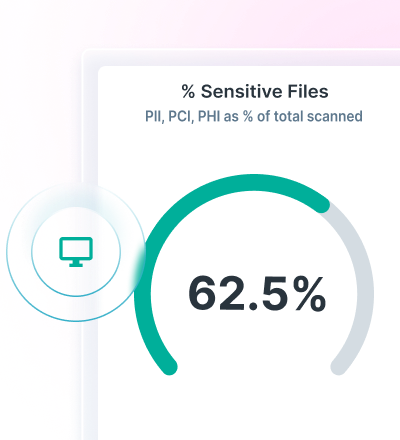
Oltre 12.000 clienti non possono sbagliarsi










































Ottieni visibilità e controllo sui dati sensibili
Ottieni maggiori informazioni sui dati oscuri grazie all'estesa raccolta di dati e alla classificazione altamente accurata.
Il software Forcepoint DSPM esegue la scansione di qualsiasi fonte di dati e utilizza la tecnologia AI Mesh proprietaria per identificare, categorizzare e correggere i dati ad alto rischio.
È una soluzione perfetta se i vostri team di sicurezza hanno difficoltà con:
Grandi quantità di dati shadow
Dati con autorizzazioni eccessive
Rischi di perdita di dati dell'IA generativa
Posizioni dei dati non identificate
Forcepoint DSPM Software Leads the Pack
Forcepoint is the only Data Security Posture Management vendor that uses AI Mesh technology to deliver highly accurate data classification. Read the full comparison chart to learn why organizations trust the leading data security provider to discover and catalogue data and remediate risk at scale.
20%
40%
60%
80%
100%
Forcepoint
Traditional Vendor
Data Governance
Vendors
DSPM: Forcepoint VS concorrenza
Forcepoint | Fornitore tradizionale | Fornitore di governance dei dati | |
Classificazione dei dati
| |||
Rilevamento dei dati
| |||
Scalabilità
| |||
Suite di analisi:
| |||
Analisi degli incidenti
| |||
Personalizzazione ed estensibilità
| |||
Approccio basato sul rischio
|
Il confronto dei prodotti si basa sulle funzionalità interne al prodotto e sulle integrazioni cross-portfolio disponibili dallo stesso fornitore a partire dal 7 maggio 2024. I confronti non includono integrazioni con venditori di terze parti. Il confronto delle funzionalità si basa sulla versione più recente e moderna di ciascun fornitore disponibile a partire dal 7 maggio 2024. Le informazioni si basano sui dati raccolti da siti web e forum pubblici, articoli di analyst e schede tecniche dei prodotti a partire dal 7 maggio 2024.
Perché Forcepoint DSPM è lo strumento di sicurezza migliore in circolazione?
Visibilità dei dati migliorata
Ottieni una visibilità completa sui dati strutturati e non strutturati in tutti gli ambienti cloud e on-premise per monitorare e gestire i dati sensibili ovunque si trovino.
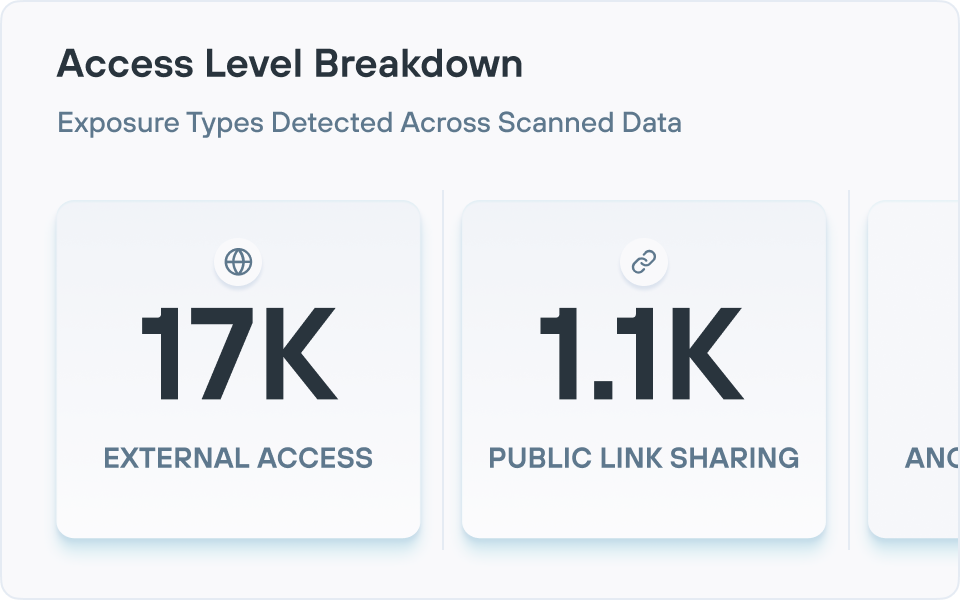
Scoperta e classificazione dei dati con l'aiuto dell'IA
Sfrutta l'elevata precisione della tecnologia AI Mesh per scoprire e classificare i dati in modo efficiente e affidabile, riducendo i falsi positivi e migliorando la precisione degli avvisi sugli incidenti
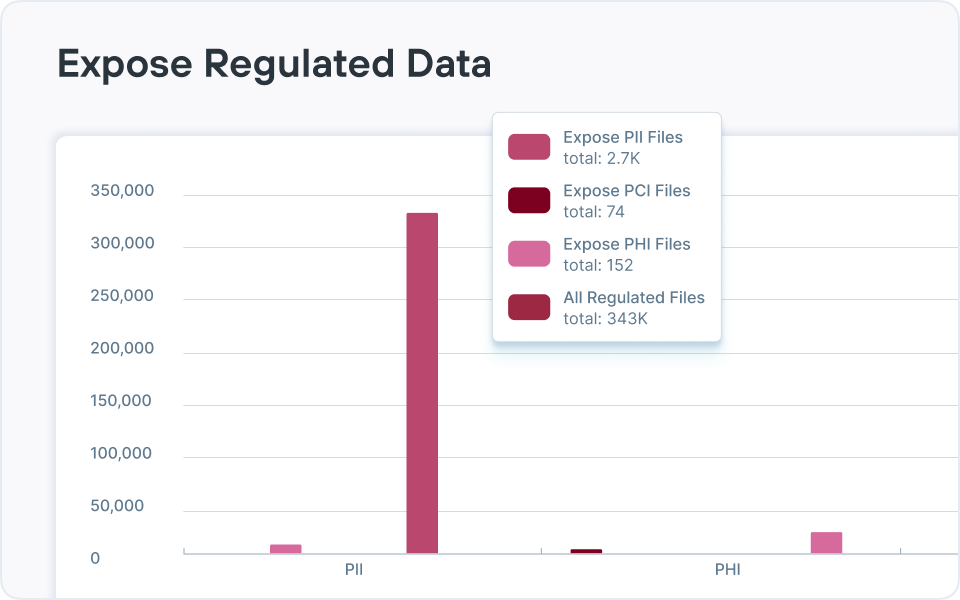
Correzione proattiva del rischio
Le informazioni traducibili in azioni consentono di gestire le autorizzazioni, trasferire i dati fuori posto e risolvere gli eventuali problemi legati alla sovranità dei dati, all'accesso e ai dati duplicati o ROT.
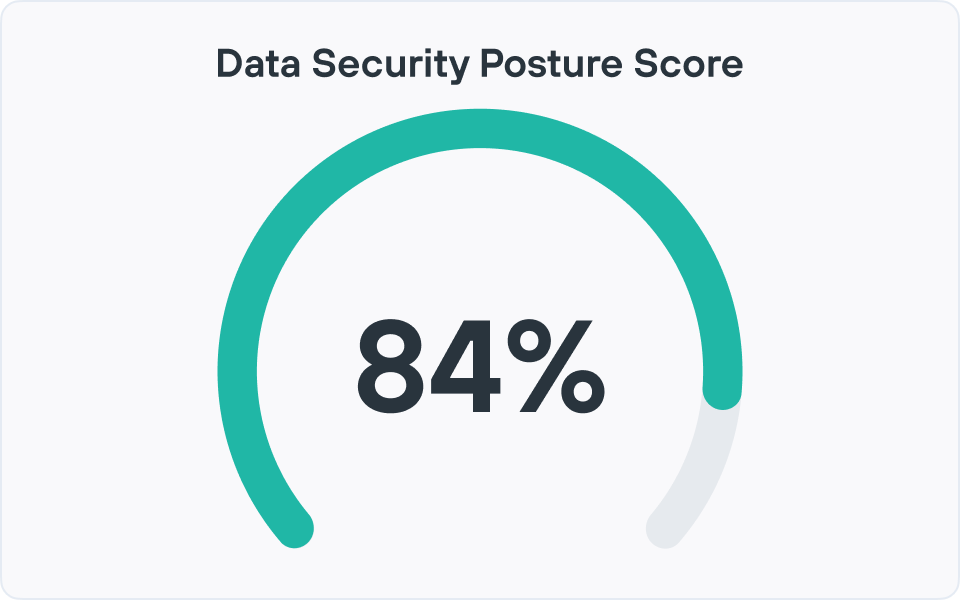
Automatizzazione della gestione della conformità
Semplifica i processi di conformità grazie all'automazione per garantire un allineamento coerente e continuo alle normative in evoluzione, riducendo lo sforzo manuale.
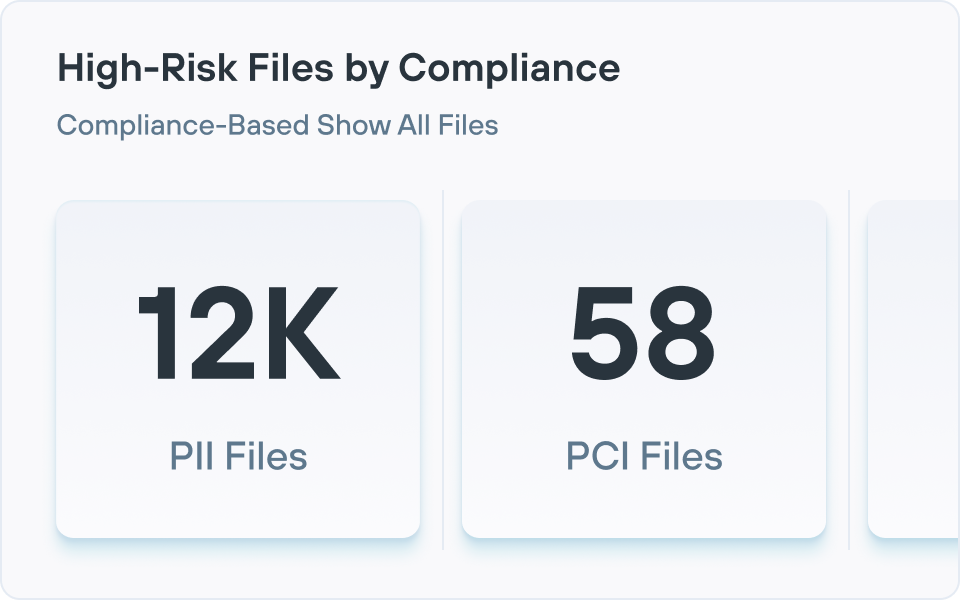


Identifica la precisione e la creazione di report trasparenti
Enda Kyne, CTOO di FBD Insurance, afferma che DSPM e DDR sono stati adottati dai suoi team di sicurezza IT e protezione dei dati per la loro capacità di controllare i dati critici e segnalare l'attività alle autorità di regolamentazione.
Strengthen Your Data Security Posture


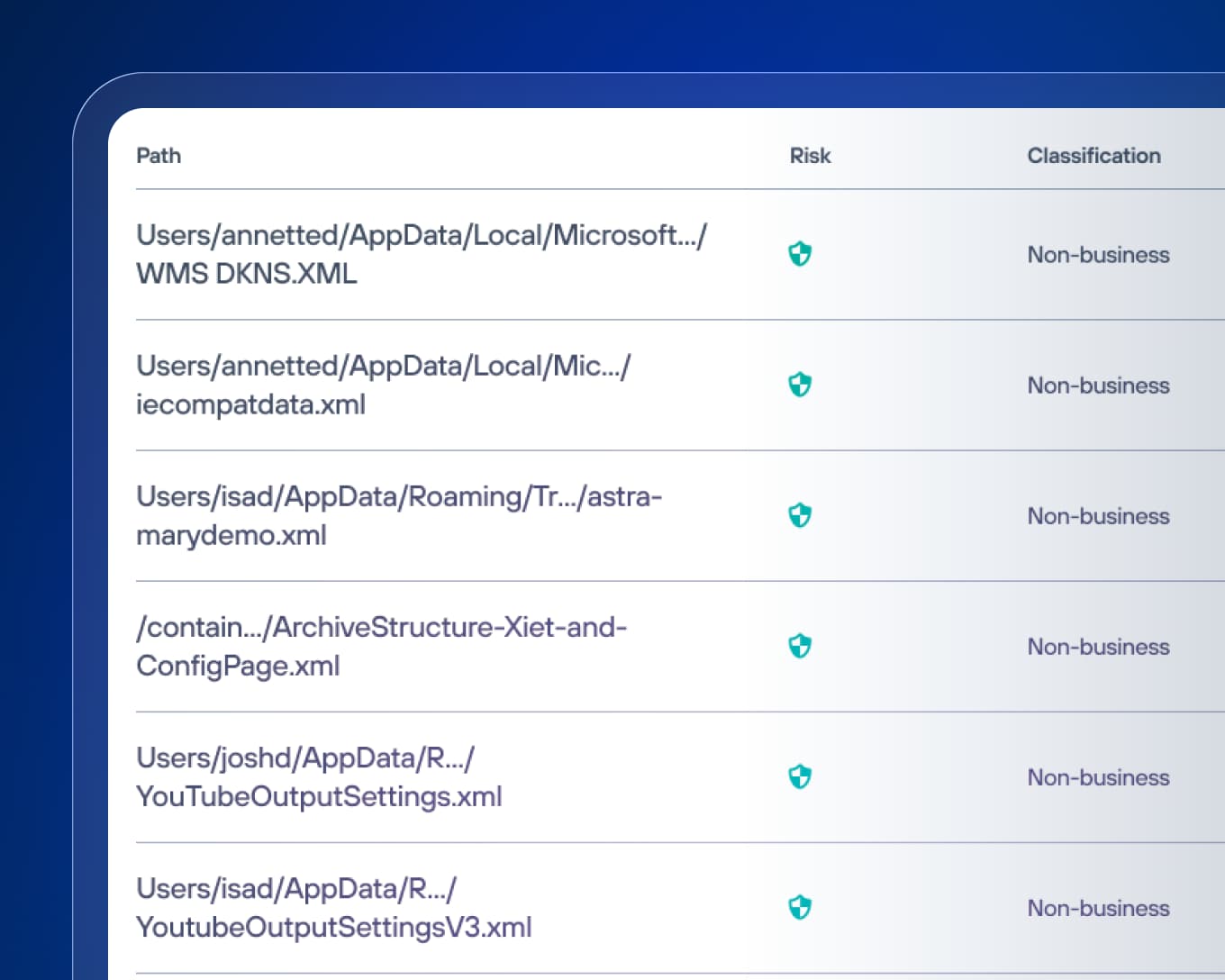

Rapidly and precisely identify sensitive data-at-rest with AI Mesh technology that fine-tunes its classification accuracy relative to your unique organizational needs.

Extend visibility and control over all your regulated data, eliminate gaps and generate automated reports to demonstrate compliance.

Gain a centralized view of your data and enforce the Principle of Least Privilege across cloud, SaaS and on-prem systems for effective governance.


i tuoi dati sono a rischio?
La valutazione del rischio dei dati rileva in modo proattivo le eventuali minacce, che si tratti di file sensibili non classificati secondo la terminologia del glossario o di utenti con autorizzazioni eccessive. Richiedi una valutazione gratuita del rischio dei dati con Forcepoint per vedere nel dettaglio come viene gestita la sicurezza dei dati (DSPM) e scoprire quanto sono sicure le tue informazioni.

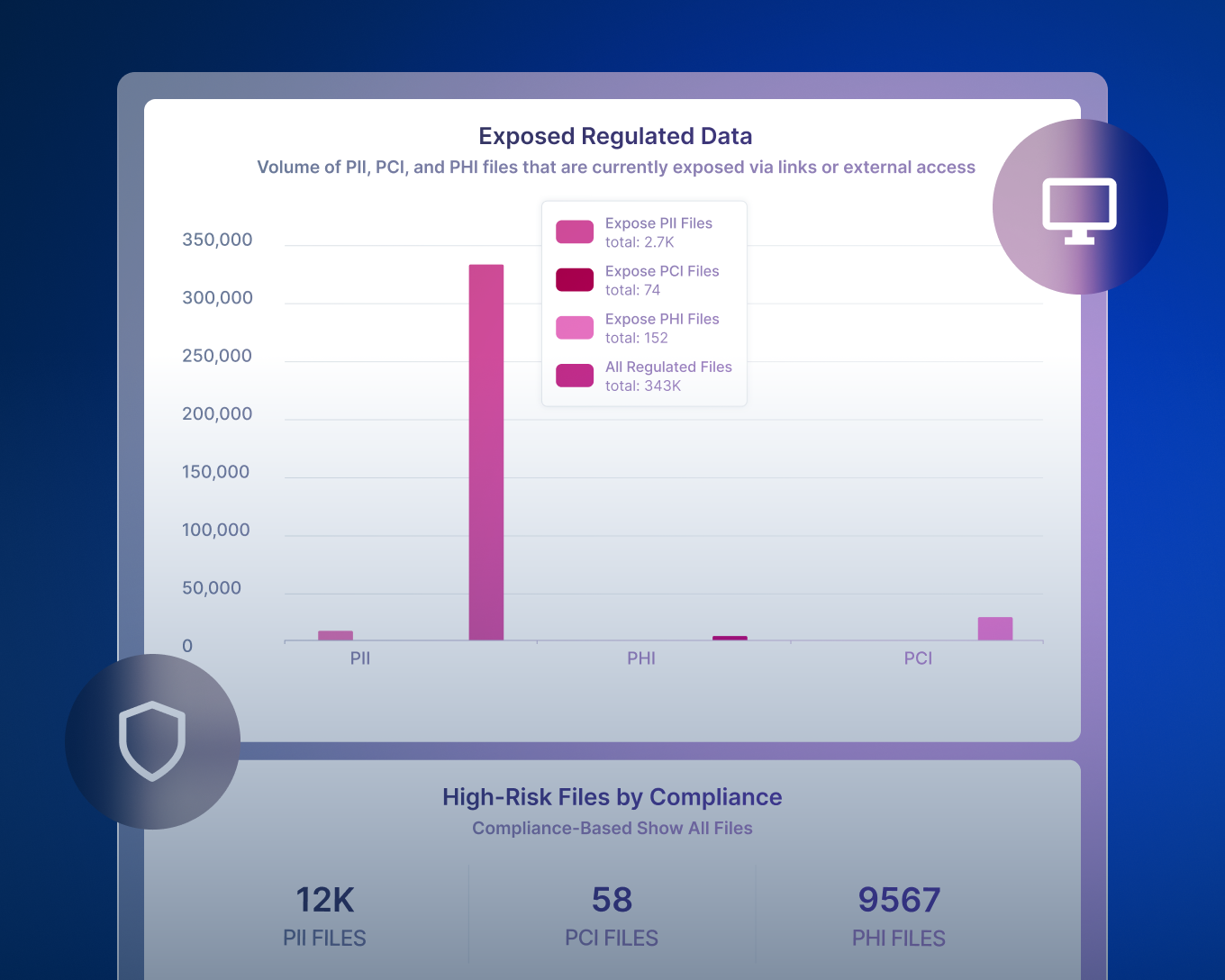


Capacità di integrare DLP, DSPM e DDR per il rilevamento, la classificazione, la protezione e la correzione dei dati.

Fornisce un reporting efficace del rischio, consentendo di visualizzare i dati ridondanti, obsoleti e banali, i dati con autorizzazioni eccessive, i problemi di sovranità dei dati e molti altri che rendono rischiosa la posizione dei dati complessiva.

Offre visibilità e controllo sulla preparazione dei dati per tutte le applicazioni GenAI. È anche in grado di proteggere l'utilizzo di Copilot e ChatGPT Enterprise.
Le storie dei nostri clienti
Le storie dei nostri clienti
"As part of Forcepoint’s broader data security ecosystem, DSPM has integrated seamlessly with our existing solutions. It’s an essential component of our overall data security strategy."
Indonesia Financial Group (IFG)
Consigliato dagli analisti.
Approvato dagli utenti.
Forcepoint è costantemente classificato tra i migliori fornitori di software di prevenzione della perdita dei dati e di sicurezza dei dati da utenti e analisti del settore.
Forcepoint è stata nominata Leader nell'IDC MarketScape: Worldwide DLP 2025 Vendor Assessment.
Forcepoint è stata nominata 2024 Global DLP Company of the Year per il secondo anno consecutivo da Frost & Sullivan.
Forcepoint è stata riconosciuta come Strong Performer in The Forrester Wave™: Data Security Platforms, primo trimestre 2025.
Implementa le best practice per la gestione della postura di sicurezza dei dati
Domande frequenti
Che cos'è la gestione della sicurezza dei dati (DSPM)?
Data Security Posture Management è una soluzione di sicurezza che scopre continuamente dove si trovano i dati sensibili, come sono classificati e chi può accedervi attraverso il cloud, il SaaS e gli ambienti on-prem.
Il DSPM nativo dell'IA di Forcepoint segue questo stesso modello: inventoria continuamente i dati strutturati e non strutturati, utilizza la tecnologia AI Mesh per classificare con precisione tali dati attraverso l'archiviazione dei file, le applicazioni cloud e le posizioni on-prem e valuta se uno qualsiasi di questi dati è a rischio attraverso una varietà di lenti.
Forcepoint DSPM aiuta ad aumentare la produttività, ridurre i costi, ridurre il rischio e semplificare la conformità trasformando la postura da un audit periodico in una vista in esecuzione dal vivo del rischio dei dati.
Come funzionano le soluzioni DSPM?
La maggior parte delle piattaforme DSPM segue un ciclo di vita ricorrente: scopri i dati (strutturati e non strutturati attraverso più cloud e on-prem ), classificali per sensibilità e contesto aziendale, valuta e dà priorità ai rischi (come l'accesso eccessivamente privilegiato o i dati sbagliati), risolvi le configurazioni errate o l'accesso non sicuro e quindi monitora continuamente per mantenere la posizione aggiornata.
Forcepoint DSPM implementa questo con AI Mesh, un'architettura di classificazione dell'IA che utilizza piccoli modelli linguistici e reti neurali profonde. i dati Forcepoint DSPM scansiona le fonti di dati integrate, identifica e categorizza i dati ad alto rischio e raccomanda i passaggi successivi per la risoluzione in modo che il team possa regolare le autorizzazioni, spostare i dati smarriti, pulire i dati ridondanti, obsoleti o banali (ROT) e risolvere i problemi di sovranità invece di fermarsi ai report.
Gli aggiornamenti recenti estendono Forcepoint DSPM oltre i file nei database aziendali e nei laghi di dati, in modo che lo stesso modello di scoperta, classificazione e applicazione adattiva ora copre sia i dati strutturati che quelli non strutturati in un'unica piattaforma unificata insieme a Forcepoint DDR e DLP.
Come funzionano le funzionalità di scoperta dei dati del software DSPM?
DSPM rileva continuamente i dati nello storage cloud, di rete e on-premise per scoprire e catalogare ogni dato che la tua organizzazione ha. Trovare i dati sensibili è il primo passo fondamentale per proteggerli. Le soluzioni DSPM scansionano il tuo intero ecosistema di dati come:
- Piattaforme cloud (AWS, Azure, GCP)
- Applicazioni SaaS (Microsoft 365, Salesforce)
- Archiviazione e database on-premise sicurezza
Il moderno software DSPM mantiene la visibilità continua mentre i dati si spostano e cambiano attraverso funzionalità integrate o integrazioni di soluzioni.
Quali funzionalità di classificazione dei dati e valutazione del rischio fornisce una soluzione DSPM?
Una soluzione DSPM matura offre una catena di funzionalità:
- Scoperta dei dati e classificazione basata sull'IA: scansione automatizzata del cloud, del SaaS, degli endpoint e degli archivi on-prem, utilizzando l'IA finemente regolata per classificare con precisione i dati strutturati e non strutturati in base alla sensibilità e allo scopo aziendale, con modelli personalizzabili per ridurre i falsi positivi.
- Valutazione del rischio dei dati più l'analisi e la priorità del rischio: crea un inventario di dati sensibili, quindi valuta il rischio in base all'esposizione, all'accesso eccessivamente permissivo e all'impatto aziendale in modo che i team si concentrino per primi sui set di dati più critici; Forcepoint utilizza la valutazione del rischio e le stime dell'impatto finanziario per dare priorità alla mitigazione.
- Governance degli accessi: far emergere chi ha accesso a quali dati, evidenziando la condivisione pubblica o esterna, gli account inattivi e le cartelle condivise eccessivamente, con una visibilità profonda sulle autorizzazioni tramite le integrazioni delle directory.
- Conformità e reporting: generazione di dashboard, trail di audit e report allineati al framework (per normative come GDPR o HIPAA) che mappano i dati regolamentati, i controlli dei documenti e semplificano gli audit; Forcepoint aggiunge modelli di politiche, report automatizzati e classificazione dell'IA spiegabile per semplificare la dimostrazione della conformità attraverso gli ambienti ibridi.
In che modo una piattaforma DSPM aiuta le organizzazioni a gestire e risolvere il rischio?
Identificare i problemi senza risoluzione crea poco valore. Le moderne piattaforme DSPM colmano questa lacuna con controlli personalizzabili che si adattano alle esigenze e alle sfide uniche della tua organizzazione. Questi controlli includono la gestione delle autorizzazioni per implementare il principio del privilegio minimo (PoLP), garantendo che gli utenti accedano solo ai file necessari per le loro attività e gestendo i dati con autorizzazioni eccessive o accessibili pubblicamente. Le funzionalità aggiuntive includono la mappatura dei dati per classificare correttamente le informazioni sensibili, la correzione dei dati posizionati in modo errato per indirizzare i file archiviati in repository inappropriati e i flussi di lavoro di archiviazione/eliminazione dei dati per la gestione dei file a rischio che sono passati i periodi di conservazione o sono classificati come ROT (ridondante, obsoleta, banale).
Come funzionano i report e le analisi all'interno del software DSPM?
Le soluzioni DSPM includono strumenti di reportistica e analisi che forniscono visibilità sullo stato di sicurezza dei dati generale di un'organizzazione. Queste funzionalità di reporting in genere presentano dashboard che mostrano dove si trovano i dati sensibili in tutti gli ambienti, evidenziando i fattori di rischio specifici come i dati ROT (ridondanti, obsoleti, triviali), i file con autorizzazioni eccessive, le informazioni ubicate in modo errato e i contenuti duplicati. I team di sicurezza possono utilizzare queste informazioni per tenere traccia delle metriche nel tempo e dare la priorità agli sforzi di correzione dove avranno il massimo impatto.
Forcepoint DSPM è distribuito on-premise o nel cloud?
Le soluzioni DSPM offrono opzioni di implementazione flessibili:
- SaaS nativo per il cloud per una distribuzione rapida sicurezza
- Modelli ibridi per ambienti sensibili
- On-premise per il controllo della sovranità dei dati sicurezza
- Architetture senza agente per ridurre al minimo le spese generali
La maggior parte delle aziende inizia con i propri repository di dati più critici e espande la copertura in modo incrementale.
Come Forcepoint DSPM usa l'IA e l'automazione?
L'automazione consente il rilevamento e la scansione dei dati continui e su larga scala in tutti gli ambienti aziendali. Le organizzazioni possono ora classificare automaticamente i dati in tempo reale non appena vengono creati, spostati o modificati, eliminando i ritardi e le lacune inerenti alle revisioni manuali. Il valore principale dell'intelligenza artificiale risiede nel fornire una classificazione dei dati altamente accurata e nel ridurre i falsi positivi. L'IA fornisce la precisione necessaria per distinguere con sicurezza tra i dati veramente sensibili e le informazioni innocue che potrebbero attivare i sistemi tradizionali basati su regole. i dati Affinché le soluzioni DSPM incorporino con sicurezza queste funzionalità, le soluzioni moderne devono gestire un'ampia gamma di tipi di file, dai PDF ai video, e comprendere una gamma ancora più ampia di campi di dati per assegnare classificazioni corrette e regolarsi in base ai requisiti di conformità. Ciò include lo sfruttamento delle funzionalità di IA generativa, dei classificatori di rete neurale profondi e di altre tecnologie di IA predittiva che lavorano insieme i dati.
Quali sono i vantaggi chiave che le organizzazioni potrebbero ottenere dall'implementazione di una piattaforma DSPM?
I vantaggi della gestione della posizione della sicurezza dei dati possono ridursi a quattro risultati:
- Aumenta la produttività
- Taglia i costi
- Riduzione del rischio
- Semplifica la conformità
Il DSPM si integra con altre tecnologie di sicurezza?
Il DSPM funziona raramente in isolamento. La maggior parte delle organizzazioni lo integra con le tecnologie di sicurezza complementari per creare una strategia di protezione dei dati completa. Le informazioni che il software DSPM fornisce sulla posizione dei dati, sulla sensibilità e sul rischio migliorano naturalmente altri strumenti di sicurezza come:
- Data Detection and Response (DDR)
- Data Loss Prevention (DLP)
- Cloud Access Security Broker (CASB)
- Identity and Access Management (IAM)
- Cloud Security Posture Management (CSPM)
In che modo DSPM si differenzia dagli strumenti di classificazione dei dati legacy?
A differenza degli strumenti tradizionali che lavorano con repository di dati noti che utilizzano regole predefinite, DSPM scopre continuamente dati noti e sconosciuti in tutti gli ambienti, sfruttando l'IA per una classificazione più accurata e fornendo contesto sui modelli di accesso e sui controlli di sicurezza.
Come DSPM aiuta a valutare la posizione della sicurezza?
Data Security Posture Management (DSPM) valuta la posizione della sicurezza scoprendo continuamente dove si trovano i dati sensibili (cloud, SaaS, on-prem ), classificandoli per sensibilità e mappando chi ha accesso ad essi.
Forcepoint DSPM utilizza il suo motore AI Mesh oltre a ampi connettori per inventariare i dati strutturati e non strutturati. Evidenzia i file sovraesposti, i dati ROT e le autorizzazioni rischiose e li correla in una valutazione del rischio dei dati.
Fornisce quindi il monitoraggio e l'analisi ad alte prestazioni per mostrare quanti dati sensibili sono a rischio, quali sedi e unità aziendali guidano la maggior esposizione e come i cambiamenti nel tempo influiscono sul rischio dei dati complessivi. Queste informazioni vengono riportate attraverso dashboard e report dettagliati, dando ai team di sicurezza e conformità una visione attuale e misurabile della loro posizione di protezione dei dati anziché audit puntuali.
Qual è la differenza tra SSPM e CSPM e DSPM?
CSPM (Cloud Security Posture Management) si concentra sull'infrastruttura cloud: configurazioni, controlli di rete, identità e servizi di piattaforma. Trova e aiuta a risolvere le configurazioni errate negli ambienti IaaS, PaaS e SaaS, non i contenuti dei dati stessi.
SSPM (SaaS Security Posture Management) si concentra sulle applicazioni SaaS: impostazioni di sicurezza, accesso e integrazioni attraverso i servizi come Microsoft 365, Salesforce e altro ancora.
DSPM (Data Security Posture Management) si concentra specificamente sui dati: scopriendo, classificando e valutando il rischio intorno alle informazioni sensibili ovunque siano archiviate. Risponde, "quali dati abbiamo, dove sono, chi può accedervi e quanto è rischiosa l'esposizione?"
Forcepoint DSPM ha il monitoraggio e il rilevamento dei rischi in tempo reale?
Sì.Forcepoint DSPM fornisce una valutazione del rischio in tempo reale o ad alta frequenza mentre esegue la scansione, aggiornando le dashboard con i livelli di esposizione e sfruttando un sistema di avviso avanzato per segnalare automaticamente le anomalie e le potenziali violazioni.
Come DSPM migliora la sicurezza del cloud?
DSPM migliora la sicurezza del cloud dando visibilità completa sui dati sensibili archiviati attraverso l'archiviazione cloud, le piattaforme SaaS e i database. Mostra esattamente quali dati esistono, quanto sono sensibili, dove risiedono e come vengono condivisi.
Forcepoint DSPM scansiona i principali fornitori di cloud e le fonti di identità per scoprire i dati sovraesposti, le autorizzazioni eccessive e i contenuti sensibili sbagliati che gli strumenti cloud tradizionali perdono.
Con questo contesto, i team di sicurezza possono applicare l'accesso con il privilegio minimo nel cloud, dare priorità alla risoluzione in base all'impatto aziendale e normativo reale e integrare i risultati DSPM con DLP e altri controlli.
Quali sono i vantaggi dell'utilizzo di DSPM nella sicurezza del cloud?
L'utilizzo di DSPM negli ambienti cloud offre risultati concreti: esposizione dei dati ridotta (attraverso il rilevamento della sovraesposizione e la pulizia delle autorizzazioni), meno punti ciechi attraverso il multi-cloud e SaaS e una migliore protezione per l'IP e i dati regolamentati.
Forcepoint AI Mesh migliora la precisione della classificazione di Forcepoint DSPM, che taglia direttamente i falsi positivi e aiuta i team a concentrarsi sul rischio reale.
Migliora anche l'efficienza operativa tramite l'automazione, le dashboard integrate e la segnalazione. Accorcia i cicli di indagine e risoluzione, riduce i costi di archiviazione e governance affrontando i dati ROT e affronta la preparazione alla conformità per gli audit e le normative sulla protezione dei dati.
DSPM aiuta con l'individuazione della minaccia e la risposta alle minacce dell'identità?
DSPM non è una piattaforma di rilevamento e risposta delle minacce delle identità (ITDR), ma Forcepoint DSPM rileva i rischi relativi all'identità legati ai dati. i dati Mappa quali utenti e gruppi possono accedere ai file sensibili, evidenzia gli "utenti rischiosi" con autorizzazioni eccessive o ad alto impatto e fa emergere i modelli di accesso sospetti tramite analisi e avvisi.
Queste informazioni consentono ai team di sicurezza di indagare rapidamente sui potenziali usi impropri delle identità (ad esempio, un utente con accesso eccessivo ai dati critici) e intraprendere azioni mirate come revocare l'accesso, rafforzare la condivisione o attivare i flussi di lavoro negli strumenti di sicurezza esistenti, rafforzando la protezione dei dati incentrata sull'identità senza indovinare.
Come DSPM rileva e valuta l'esposizione dei dati sensibili?
Forcepoint DSPM utilizza i connettori per scansionare gli archivi di dati cloud e on-prem su scala, quindi applica la classificazione AI Mesh e i rilevatori configurabili per identificare i dati sensibili (PII, PCI, PHI, IP, ecc.) in base al contenuto e al contesto.
Quindi valuta l'esposizione analizzando le impostazioni di condivisione e le autorizzazioni per contrassegnare i dati che sono pubblici, condivisi esternamente, eccessivamente condivisi internamente, spostati o associati a utenti rischiosi e quantifica tale rischio all'interno delle dashboard e dei report in modo che i team possano dare priorità alla risoluzione.
Come DSPM semplifica la segnalazione della conformità?
Forcepoint DSPM centralizza le prove necessarie per le normative come GDPR, HIPAA e altri requisiti di privacy e sovranità documentando continuamente dove risiedono i dati regolamentati, come sono protetti e chi può accedervi. La sua funzione di segnalazione e la suite di analisi mostrano la preparazione alla conformità e il rischio dei dati attraverso i framework popolari.
Quali dashboard sono incluse in Forcepoint DSPM per i team di conformità?
La suite Forcepoint DSPM Analytics include dashboard predefinite come l'analisi della sovraesposizione, l'analisi dell'esposizione al ransomware, la duplicazione dei dati critici, il rilevamento degli utenti rischiosi, la conservazione dei dati, i dati smarriti, la valutazione del rischio dei dati e il monitoraggio degli incidenti per le violazioni del controllo dei dati.
I team di conformità possono anche creare dashboard personalizzate utilizzando i widget integrati (contatori, grafici, tabelle, visualizzazioni degli incidenti, ecc.) guidati dal linguaggio delle query di DSPM ed esportare queste visualizzazioni come report per consentire loro di personalizzare la supervisione in base alle normative specifiche, alle unità aziendali o alle categorie di dati senza sviluppo personalizzato.





